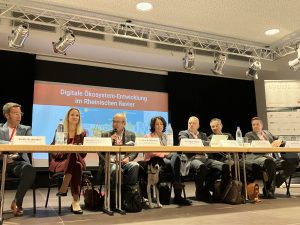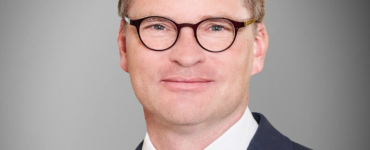Opencast lignite mining for power generation shaped the Rhenish region (“Rheinische Revier”) in the Rhineland in the west of Germany for many decades. With the energy transition, the region is facing an economic structural change. But how can the fomer coal-mining region be transformed into an “Innovation Valley Rhineland”? Around 70 experts from the digital industry discussed this in Bedburg in October.
Bedburg Castle is a Gothic moated castle from the 12th century, idyllically situated in a castle park. Digital experts from all over Germany could not have wished for a more beautiful setting to discuss the future of the region’s digital infrastructures. They were welcomed to the Knights’ Hall on 20 October 2022 by Susanne Kayser-Dobiey, Managing Director of the Rhine-Erft Economic Development Corporation, and Torsten Stamm from the town of Bedburg.
Moderated by Dr Béla Waldhauser, Leader of the eco Competence Group Data Center Infrastructure, they spent an afternoon discussing how digital infrastructures could be created locally and drive structural change. Autonomous driving, the Internet of Things, the increasing use of cloud applications, artificial intelligence and blockchain, as well as the developments of Industry 4.0, need highly available and fast Internet connections on site. “We need to process data where it is created,” said Andreas Weiss, Head of Digital Business Models at eco – Association of the Internet Industry in his opening statement. “This is the only way we can make better decisions based on data and keep value creation in our own region.”
The Rhenish region meets all the requirements
Up to 60 million users in a radius of 250 kilometres in and around the Rhenish region are already increasingly demanding data infrastructures. In order to be able to supply them from the region in the future, the establishment of modern digital infrastructures must be strategically promoted. The Rhenish region offers excellent conditions for this, said Gerd J. Simon, Independent Managing Consultant: “They have everything here to bring the party to them: electricity, space, the skilled workers and the perfect location between the two major Internet Exchanges in Amsterdam and Frankfurt a. M., they just have to invite the guests.”
Dr Sabine Tabrizi from Digital Realty, one of the largest operators of data centres worldwide, reported on the constant search for new locations, as resources for further settlements in Frankfurt a. M. are almost exhausted. Michel Düring of the DC Data Center Group confirmed this. “The Rhenish region has a high attractiveness as a location for digital infrastructures.”
Making good use of data centre waste heat
Local people would benefit, for example the waste heat generated in data centres could be used productively – e.g. in agriculture or fish farming or to heat offices, flats or swimming pools. “What goes into a data centre as electricity becomes heat that we can theoretically use,” said Dr. Ralph Hintemann of the Borderstep Institute. Even though the electricity demand of data centres is growing rapidly, the energy transition offers great opportunities. Hintemann cited Sweden as an example: “In Stockholm, the heat grids are connected to data centres.”
“This potential of the data center industry is going up in smoke, although waste heat from data centres can be a valuable alternative to fossil fuels,” said Dr. Béla Waldhauser, spokesman for the Alliance for the Strengthening of Digital Infrastructures, founded under the umbrella of the eco Association, adding: “If politics creates the right framework conditions here promptly, the use of waste heat from data centres can be one of the top solutions for saving energy costs and CO2 in the coming years.”
Bus trip to farm showed potential
After a lively discussion, the organisers immediately gave an example of how the use of waste heat from data centres can succeed. The participants travelled by bus to the Bergerhof farm in Bergheim and spoke with the operators Birgit and Michael Bong. For years, they used the waste heat from the Niederaussem power plant in the immediate vicinity to grow tomatoes and other vegetables. During the discussion, it quickly became clear that the heat generated in data centres would be ideally suited to increase Farmer Bong’s yield by up to 60 per cent. “We just need a T-piece, then we can get started right away and use the heat,” said Mr Bong. And, of course, there still needs to be the associated data centre, which could hopefully be built in the neighbourhood soon.




